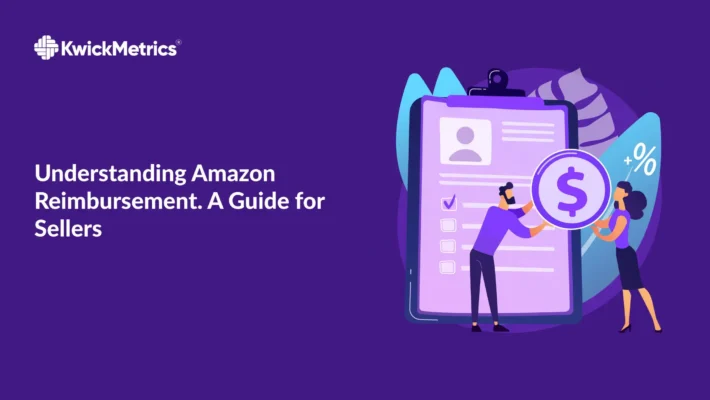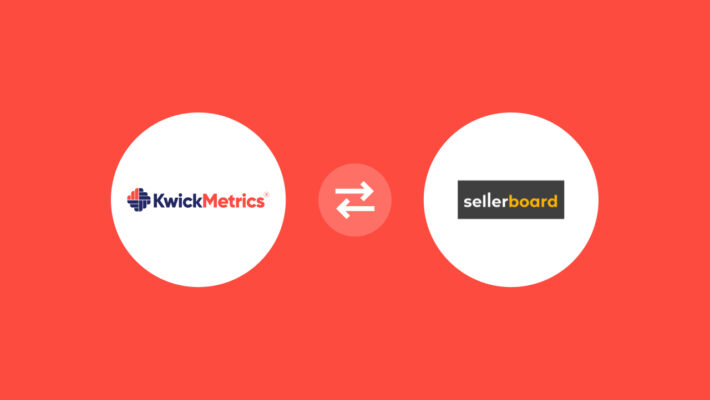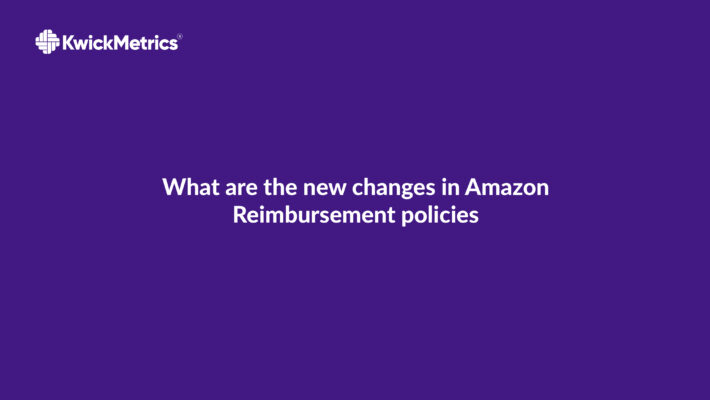Selling On Amazon FBA: Your Amazon Selling Guide

Table of Contents
- Why You Should Sell on Amazon
- Embarking on Your Amazon FBA Business Journey
- KwickMetrics - The Business Intelligence and Analytics Tool
- Sourcing Products for Your Amazon FBA Business
- Listing Your Products Effectively
- Managing Inventory & Delivering Products
- Try Our KwickMetrics - One Tool with Multiple Solutions!
- Inventory Management & Product Delivery: The Cornerstones of Amazon FBA Success
- Unlocking Growth Potential After Initial Sales
- FAQs in Relation to Selling on Amazon FBA
- Explore Our Features!
- Conclusion
Selling on Amazon FBA can feel like navigating through a labyrinth.
Indeed, when it’s time to launch and expand, the most significant hurdle is…
Selling on Amazon FBA.
You’re left clueless about how to go about it. This uncertainty is what differentiates an amateur seller from a successful entrepreneur. But if you don’t learn how to effectively sell using Amazon’s Fulfillment by Amazon (FBA) service, reaching this level will remain just a dream.
Folks, selling successfully on this platform isn’t easy!
Consider one aspiring seller who told me that as soon as he listed his first product… he was hit with an unexpected storage fee.
Now he’s hesitant to list more items or even continue selling at all because of fear for unforeseen costs or challenges.
No surprises there!
Why You Should Sell on Amazon
The prospect of becoming a successful Amazon FBA seller is more appealing than ever, especially in light of the projected boom in e-commerce sector. With an estimated value set to hit US$ 99 billion by 2024, it’s clear that this market offers vast potential for profit.
Amazon’s robust platform provides sellers with access to its speedy delivery capabilities and massive customer base. The benefits are further amplified when you consider programs like Amazon Prime, which promises fast shipping options that shoppers find incredibly attractive.
Riding the Demand Wave
A key aspect of selling on Amazon involves tapping into its enormous growth potential. As one of the world’s largest manufacturing hubs, India presents unique opportunities for those ready to ride this wave towards establishing profitable businesses.
To become a successful Amazon FBA seller requires strategic alignment with rising trends within your chosen niche. By ensuring your business model resonates with these trends, you can guarantee consistent demand for your products and maintain steady sales volume over time.
Leveraging Logistics
Beyond capitalizing on consumer demand patterns, leveraging logistics forms another crucial component contributing significantly towards running a thriving Amazon FBA business. Utilizing Amazon’s warehouses gives sellers direct access to their extensive distribution network – essential for reaching target customers efficiently across different regions.
This logistical advantage combined with effective inventory management practices ensures high consumer demands are met promptly while maintaining optimal service levels at all times.
Moreover, having finished products stored close to end consumers reduces shipping times considerably, enhancing overall customer experience leading to ultimately higher sales conversions.
This comprehensive approach allows professional Amazon sellers not only to start selling but also to sustain long-term success in their ventures.
Key Takeaway:
Dive into the Amazon FBA selling pool to tap into booming e-commerce market. Ride the demand wave with strategic alignment to trends, leverage logistics for efficient distribution, and maintain optimal service levels for long-term success.
Embarking on Your Amazon FBA Business Journey
The path to becoming a successful Amazon FBA seller is paved with strategic planning and diligent execution. From setting up your Amazon seller account, crafting an effective business plan, identifying the right niche market, sourcing high-demand products, listing them optimally on Amazon’s platform, and managing inventory levels – every step counts.
Kick-starting With Seller Account Registration
To initiate your journey in the world of e-commerce via the Amazon FBA business model, it’s crucial that you first set up an official seller account. This process demands some basic yet essential information about your enterprise along with meeting legal requirements such as GST registration for sellers in countries like Canada, Australia, India, Malaysia, Singapore.
Besides this fundamental data collection phase, furnishing banking details becomes necessary too; after all, these are the channels through which payments from sales would be received. Remember – establishing a strong foundation at this stage can significantly influence the future growth prospects of your online retail operation.
After completing the account registration on Seller Central, it’s highly recommended to create a KwickMetrics account. It centralizes all data in a concise, organized format for effortless analysis and informed decision-making. Plus, KwickMetrics grants access to lifetime data history, crucial for making impactful business decisions beyond the 18-month data limit of Seller Central.
KwickMetrics - The Business Intelligence and Analytics Tool
Explore 14-day free trial! No credit card required, cancel at any time.
Laying Down The Blueprint: Creating A Business Plan
A well-structured business plan acts like a compass guiding you towards achieving success within any venture, including running an Amazon FBA business. It encompasses key elements ranging from product research methodologies and pricing tactics to marketing strategies, which collectively play pivotal roles in determining profitability over time.
When charting out financial projections, remember to consider potential costs associated with storage fees incurred storing goods at Amazon’s warehouses, landed costs when importing items internationally, and avoid unpleasant surprises down the line. A comprehensive and flexible strategy ensures smooth sailing even amidst turbulent times, thus enhancing the chances of long-term success.
Niche Selection: Finding Your Sweet Spot
Determining what type of products you want to sell plays a significant role in carving a space for yourself in a competitive marketplace like Amazon, where a plethora of similar products cater to diverse customer needs and preferences. Hence, the importance of conducting thorough market analysis cannot be overstated.
Key Takeaway:
Starting an Amazon FBA business requires strategic planning, from setting up your seller account to crafting a robust business plan. Identifying the right niche and sourcing high-demand products are key steps towards success. Remember, every detail counts in this journey.
Sourcing Products for Your Amazon FBA Business
Product sourcing is the backbone of any successful Amazon FBA business. Finding items that are of good quality and have a reasonable price point to ensure your Amazon FBA business can generate a profit. Let’s delve into some strategies to make your product sourcing more effective.
Domestic vs International Sourcing
The initial choice in your product-sourcing journey revolves around whether to source domestically or internationally. Each route comes with its unique set of pros and cons which need careful consideration before taking the plunge.
If we talk about domestic sourcing – procuring goods within your own country – it offers certain benefits such as faster delivery times and lower shipping costs due to geographical proximity. The quality control aspect is generally better since visiting local manufacturers or suppliers becomes feasible if needed. However, this convenience might come at a cost as prices may be higher compared with international sources owing to elevated production expenses.
Moving onto international sourcing; countries like China and India where manufacturing costs are relatively low could offer significantly reduced unit cost per item even after including import duties and freight charges. But remember every coin has two sides: longer lead times, potential language barriers plus intricate customs procedures form part of this deal too.
An important concept while considering overseas procurement is ‘landed cost’. This term represents the total price once an item reaches the buyer’s doorstep, inclusive of the purchase price along with transportation fees (both inland & ocean), custom/duty charges levied by the importing nation, etc.
You might consider platforms like Alibaba or AliExpress for foreign purchases, yet always bear in mind – cheaper doesn’t mean superior. Quality should never take a backseat, hence comprehensive research regarding supplier reliability forms a crucial step here.
In conclusion: Whether opting for domestic or global resources (or vice versa), ensure all possible expenditures involved in bringing merchandise from the manufacturer right down to the customer’s doorstep have been factored in, avoiding unpleasant surprises later.
Key Takeaway:
Product sourcing is the lifeblood of a successful Amazon FBA business. Weigh up domestic versus international options, considering factors like delivery times, shipping costs, and quality control. Remember to factor in all potential expenses - don't let cheap prices blind you to hidden costs or compromise on quality.
Listing Your Products Effectively
The art of crafting compelling product listings is a crucial component in the toolbox of any successful Amazon FBA seller. A well-constructed listing does more than simply describe an item—it accentuates key features, illuminates benefits, and addresses common customer questions about your products.
This process can be likened to setting up shop on one of the busiest streets globally – Amazon’s marketplace. The goal? To make your store (product listing) as inviting and informative as possible for potential customers passing by (searching).
Optimizing Product Listings for SEO
In order to boost visibility in search results, it’s essential that you enhance your product listings with pertinent keywords. This entails integrating terms into your content that prospective buyers are likely searching when looking for items similar to yours on Amazon.
Amazon’s A9 algorithm, which powers their search engine, gives precedence to relevance and customer satisfaction. So incorporating high-demand keywords into various parts of the listing like title, bullet points, description, or backend keyword section could significantly boost its ranking.
Beyond keyword optimization though lies other influential factors such as price competitiveness and positive reviews – both play vital roles in propelling a product’s rank within Amazon’s Best Sellers list.
Managing Inventory & Delivering Products
A core aspect underpinning every thriving Amazon business model involves adeptly managing inventory levels. Overstocking leads down a path riddled with unnecessary storage fees from Amazon’s warehouses; while under-stocking culminates in missed sales opportunities due to stockouts—both scenarios detrimental towards profitability.
A robust inventory management strategy will help maintain optimal stock levels based upon historical sales data or projected demand patterns during peak seasons/promotional events.
Delivering products via FBA stands beneficial not just because it leverages a powerful distribution network but also offers services like order handling/packing/shipping along with returns processing, saving sellers considerable time allowing them to focus on more growth strategies instead.
Try Our KwickMetrics - One Tool with Multiple Solutions!
Key Takeaway:
Mastering Amazon FBA selling involves crafting compelling product listings, optimizing for SEO with relevant keywords, and managing inventory efficiently. Remember to highlight key features in your listing, stay competitive on price and reviews, and leverage FBA's distribution network for seamless order fulfillment.
Inventory Management & Product Delivery: The Cornerstones of Amazon FBA Success
In the realm of an Amazon FBA business, inventory management is a critical factor. It’s about striking that perfect balance between meeting customer demand and avoiding unnecessary storage fees associated with overstocking.
The Art of Inventory Management
To achieve this equilibrium, consider employing inventory management software, which can forecast future product demand based on historical sales data and seasonal trends. This allows you to plan purchases strategically so as not to be left with unsold goods tying up capital or facing out-of-stock situations that result in lost sales opportunities.
Apart from using forecasting tools, another strategy worth considering is the Just-In-Time (JIT) approach where new stocks are ordered only when current ones near depletion. However, keep in mind this method requires careful planning; any delay could lead to missed sales due to the unavailability of products.
Fulfillment by Amazon (FBA): Your Logistics Partner
Selling via Fulfillment by Amazon (Amazon FBA) offers sellers an effective solution for delivering their finished products efficiently across different regions or even countries. With its powerful distribution network at disposal, sellers no longer have to worry about logistics themselves but instead focus more on enhancing their offerings or exploring new market segments. Plus, it provides quick delivery times satisfying those subscribed under the Amazon Prime program.
Tapping into the Power Of FBA’s Distribution Network:
Leveraging the benefits offered by Fulfillment By Amazon (FBA) allows businesses to reach a wider audience base, thus opening doors for increased potential buyers. Additionally, it lends credibility among consumers given the association with a trusted brand name like ‘AMAZON’. This leaves ample time for sellers to concentrate on improving product listings, increasing visibility through SEO optimization techniques, thus leading to successful conversion rates.
Key Takeaway:
Mastering inventory management and leveraging Amazon FBA's robust distribution network are key to success in an Amazon FBA business. Employ forecasting tools, consider a Just-In-Time approach, and focus on enhancing your offerings for increased visibility and conversion rates.
Unlocking Growth Potential After Initial Sales
In the world of Amazon FBA, successful sellers know that initial sales are just the beginning. The real journey starts when you explore and tap into various growth opportunities post-sale.
This approach not only boosts conversion rates, but also lays a strong groundwork for achieving sustained business triumph.
Tapping Into Advertising Tools
The power of advertising in driving product visibility can never be underestimated, especially when it comes to selling on Amazon. Pay-Per-Click (PPC) campaigns have proven particularly effective for many professional Amazon sellers.
A well-executed PPC campaign allows you to bid on keywords relevant to your products, displaying ads whenever potential customers search using those terms.
This enhances your listing’s visibility leading to increased chances of conversions – an essential aspect every seller should consider while crafting their marketing strategy.
Sponsored Products Ads is another tool worth considering as they appear directly in search results boosting exposure among target customers even further.
Leveraging Holiday Sales Events
Holiday sales events such as Black Friday or Cyber Monday present lucrative opportunities for boosting revenue significantly. These high-demand periods see shoppers actively seeking deals online; offering attractive discounts during these times could provide a substantial boost both short-term revenues and long-term customer loyalty.
Beyond major holidays, participating in Lightning Deals – time-bound promotional offers featured throughout the year – draws attention from millions of active shoppers constantly searching for special deals.
This provides yet another avenue through which savvy entrepreneurs can grow their businesses beyond initial sales by effectively leveraging available resources within this dynamic marketplace ecosystem.
FAQs in Relation to Selling on Amazon FBA
What percentage of people succeed in Amazon FBA?
Success rates vary, but estimates suggest around 10% to 20% of sellers achieve significant profitability with Amazon FBA.
Can you make money through Amazon FBA?
Absolutely. With strategic product sourcing, effective listing optimization, and smart inventory management, sellers can earn substantial profits on Amazon FBA.
How much do people make from Amazon FBA?
Earnings fluctuate widely based on factors like product type and competition. However, many successful sellers report annual revenues exceeding $100k.
Is Amazon FBA a good thing?
Yes. It provides access to millions of customers worldwide and handles logistics such as storage and shipping for your products.
Explore Our Features!
Conclusion
Selling on Amazon FBA is a golden ticket to e-commerce success.
It’s not just about listing products, it’s an art of strategic planning and execution.
You’ve learned the importance of riding the demand wave in burgeoning markets like India. You now understand how leveraging Amazon’s logistics can give your business wings.
Setting up your seller account with all legal aspects covered is key. And you know that without a solid business plan, even the best product ideas might flounder.
Finding your niche, sourcing products wisely – these are critical steps in building a profitable venture. The power of compelling listings and effective SEO cannot be underestimated either!
Managing inventory smartly while utilizing Amazon’s robust delivery network can make or break your profitability. Post-sale growth opportunities? They’re plentiful if you know where to look and how to leverage them!
If this sounds overwhelming, don’t worry! KwickMetrics, our Business Intelligence and Analytics Tool for Amazon Sellers has got you covered. It simplifies every step from product performance report to sales analysis so that selling on Amazon FBA becomes less daunting and more rewarding for you! Ready for profitable success?




